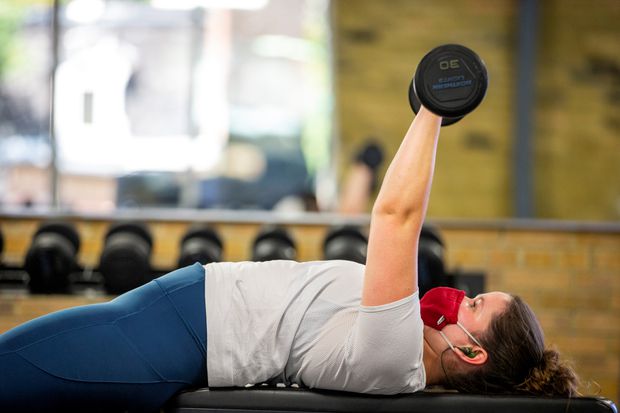Rachel Aitken works out at Hone Fitness in Toronto, July 31, 2020.
CARLOS OSORIO/Reuters
Six months.
It’s not a particularly long period of time. If we’re talking about the span of human history or the lineage of ancient California redwoods, five months is but a drop in the ocean. Switch the subject to something more tangible, though – our actual lives, for example – and those months begin to matter a whole lot more. Anyone interested in spending half a year in prison?
Didn’t think so.
Unfortunately, prison is almost what the last six months have felt like for some. I’ve heard from several people who have barely left their homes since the COVID-19 response measures were put in place back in March. Their mental health is most precarious, but their physical health isn’t much better. It can be tough to stay in shape when you’re afraid to leave your home. Maybe theirs is one of those cushy minimum security sort of jails, the kind where white collar criminals get to roam freely among lush green gardens when they’re not lounging in their private rooms. But still, it’s a jail nonetheless, where freedom is restricted and the simple pleasures that often make life special are just out of reach.
Unless Hollywood has been lying to me all these years, in every prison there lives a learned lifer whose days are spent poring over classic works of literature and philosophy. Rather than mingle with the rank and file, this wizened sage sticks to their cell, seeking answers to life’s great questions. This valuable knowledge is then shared with a naive newcomer and an unbreakable bond is formed.
Well, in this metaphor I’m the hardened old-timer and you, dear reader, are the new fish. I’ve been studying how the body works for most of my life. The lockdown allowed me to re-examine many of the theories I took as gospel. What follows are the most powerful lessons I learned during these months of introspection and research. Take notes and your health may just survive the next lockdown.
Volume ≠ Gains
The most common misconception about strength training is that “more” is better. More reps, more sets, more weight (that last one is an especially pernicious myth). The simple fact is, more is not better. “More” often only leads to broken bodies and bruised egos. So what then is the formula for fitness? There are many, but my personal preference is: Intensity of Effort + Quality of Movement = Gains For Days.
If you’re choosing the right exercises for your goals and the right variations for your abilities, then you’ll almost always be working at a near-maximum effort. Take push-ups, for example. I’ve gotten pretty good at push-ups over the years, to the point where the traditional variation doesn’t pose much of a challenge. Lately I’ve been practising a much tougher variation called the pike push-up (a.k.a., the A Frame Press Up) – think a downward dog where you lower your head to the floor by bending your elbows, then reverse the movement by extending your arms.
Because you have to move so slowly, this exercise blasts the shoulders and triceps. At the skill level I’m working at, I can barely get five reps before my form falls apart. After that, if I still have some gas in the tank I can simply walk my feet back, assume a high plank position, and fire off some push-ups to failure … which won’t take long, mind you. Three sets of that and your chest and shoulders will be fried.
Stretching ≠ Mobility
Let it be said first, loud and clear, that I love stretching. Love it! I stretch every day, mostly my upper back, neck, hips and quads. Stretching feels good, takes next to no effort, and it allows for a quiet opportunity to check in with oneself. I consider stretching to be an essential component of my daily self-care routine.
Here’s the thing, though. I’ve been stretching my stiff and sore trapezius muscles every day for Lord knows how long, and all it has ever brought me was brief moments of relief. That’s because stretching doesn’t lead to any lasting change in a muscle’s shape, size or function. Which makes sense when you consider our above-stated fitness formula. How much intensity of effort does stretching demand? Not much, not unless you’re attempting something outside of your wheelhouse, like say the splits, in which case your quality of movement will likely be nil.
In order for it to provide any lasting benefits, mobility work has to pose a challenge, and you have to be able to modify it as your abilities improve. It wasn’t until I started practising bear walks – and the many variations this exercise offers – that the pain in my neck and traps that’s been nagging me for years, finally went away. And wouldn’t you know it, when the pain disappeared, like magic the full range of motion in my left shoulder reappeared. Mobility work matters, but like anything else in life you’ve got to invest some sweat equity to reap the full rewards.
Paul Landini is a personal trainer and health educator in Toronto.
Sign up for the weekly Health & Wellness newsletter for the latest news and advice.


